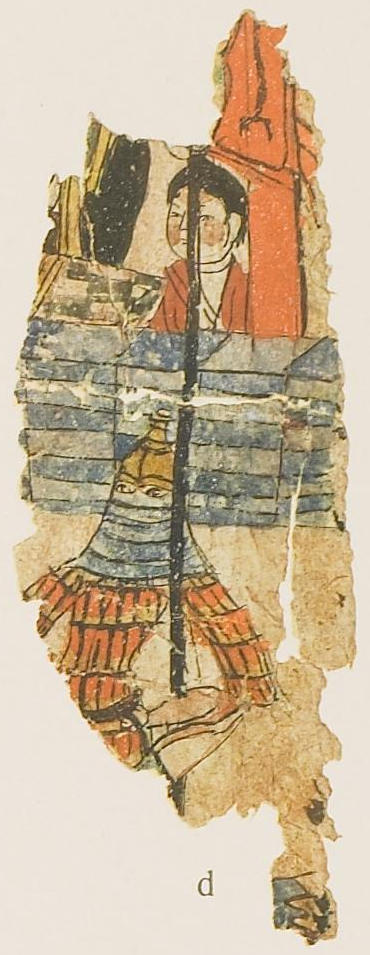
Try Amazon Audible Premium Plus and Get Up to Two Free Audiobooks
Uighur Face Defence, Chotscho, Tarim Basin



Miniature from a Uighur scroll. Found in ruin "K", Chotscho.
This fragment shows a warrior in full armour. He stands in front of a wall, behind which, in a niche next to a red post, the upper body of a young woman in reddish brown clothes is visible. A person dressed in black may have stood next to the woman.
The warrior carries a long, black-headed lance whose red banner, decorated with pennants, flutters to the right above the woman's head. On his head he wears a yellow, conical helmet, on the lower edge of which a gray-blue armoured curtain, a kind of mail cowl, which leaves only the eyes and protects the face, throat and neck to the outer edge of the shoulders, is attached. The way in which it was made cannot be recognized; after the parallel, slightly curved horizontal lines, one can think of platelet armour, perhaps also of slat-armour. The body armour shown in red and yellow seems to be of the latter type. The forearm seems to lack armour protection. A black belt encircles the warrior's body; hanging from it, on the left, is a bowcase containing a very small bow. Remnants of Uighur writing appear on the right edge of the picture.
Source: Plate 47d, A. von Le Coq, Chotscho, Berlin, 1913
Referenced as figure 63, p.57, Bilderatlas zur Kunst und Kulturgeschichte Mittel-Asiens : vol.1 by Albert von Le Coq
fig. 63 Miniature on paper, from Xoqo, 8th-9th Century.
Yellow pointed-cone-shaped helmet. Blue composite helmet, only the eyes visible through an aventail of armoured (?) platelets; short-sleeved armour of yellowish-red, at the bottom of yellow, rectangular, vertical plates between horizontal hardened (boiled) leather (?) strips. On a belt to left and rear a bow in a blue bowcase. Black lance with (not depicted) a red flag with tethered corners.
Museum of Ethnology.
Referenced by note 7 in "Oriental Armour of the Near and Middle East from the Eighth to the Fifteenth Centuries as Shown in Works of Art", by Michael Gorelik, in: Islamic Arms and Armour, ed. Robert Elgood, London 1979
A hood of mail, sometimes drawn over the face descending to the shoulders, was also worn. Extra protection could be given to the top of the head by the addition of a metal plate which is indicated by a finial spike (fig. 54). Popular from the sixteenth to nineteenth centuries, these mail helmets were known by the Caucasian/Russian term missiourka (the ‘Egyptian’ helmet).
The Varqeh va-Golshāh miniatures depict elbow-length mail capes, enclosing the face, with slits for the eyes, and covering the chest and back (fig. 63), which also show what appears to be a high, conical hat worn beneath this hood. Iranian mail capes of the thirteenth century were the result of the presence of the Crusaders in Syria and Egypt at the end of the twelfth century. The covered face mail defence may be a continuation of the late Sasanian/Iranian tradition, or that of the seventh- to ninth-century Soghdian/Central Asian one.7
7 H. R. Robinson, op. cit., Fig. 11; A. von Le Coq, Chotscho, Berlin, 1913, Taf. 47d; A. M. Belenitsky, The Monumental Art of Pendzhikent, Moscow, 1973, Tables 8, 12.